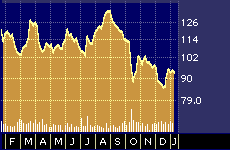
How IBM Beat Earnings Estimates
How IBM Beat Earnings Estimates
By Hal Plotkin
CNBC.com Silicon Valley Correspondent
Jan 17, 2001 04:59 PM

One-day performance of IBM.
International Business Machines Corp. {IBM} exceeded fourth-quarter earnings estimates Wednesday, when it reported that profits rose 28%. Big Blue’s stock has soared Thursday, rising as high as 108.50, or about 12%.
The Armonk, N.Y.-based company reported fourth-quarter net income of $2.7 billion, or $1.48 a share, compared with net income of $1.12 a share a year earlier. Analysts had estimated the company would report a profit of $1.46 a share, according to a First Call Corp. consensus estimate.
Sales came in at $25.6 billion, up 6% from the year-earlier quarter, and slightly below Wall Street’s forecast of $25.5 billion.
How did the company manage to beat estimates?
No one ever got fired for buying from IBM.
That familiar phrase has been the bane of International Business Machines Corp.’s {IBM} competitors for decades.
It is also one of the reasons IBM is expected to come through the current earnings season in better shape than many of its hard-pressed tech competitors, particularly those in the beleaguered personal computer sector, such as Apple Computer Inc. {AAPL}, Gateway Inc. {GTW} and Hewlett-Packard Co. {HWP}, all three of which depend far more heavily on the saturated desktop PC markets that IBM has, rather smartly it turns out, stepped away from in recent years.
IBM’s report is one of the few bright spots in the otherwise largely disappointing technology sector, which has been struggling through one of its dreariest periods in recent years.
The results may also portent an even brighter future for IBM because the numbers make it clear that the company is benefiting from market uncertainty that is helping steer often-skittish corporate buyers away from many less well-known competitors.
“In this climate IBM’s name is a very big asset,” says Shawn Willett, principal analyst at Current Analysis, based in Sterling, Va. “If you’re an [information technology] buyer you’ve probably already been burned recently by buying a product from a company that no longer exists or that doesn’t support the product. That’s all working to IBM’s advantage right now.”

One-year performance of IBM.
During the early years of the PC and distributed computing revolution IBM was tagged with a richly deserved reputation for being stodgy and cautious. The detractors said IBM focused too much on existing markets and customers and paid too little attention to the advent of supposedly more cutting-edge technologies. Today, those supposed faults have morphed into major selling points, particularly for corporate customers.
“I’ve seen a lot of cases where [competitor] BEA Systems Inc. {BEAS} won the technical evaluation but IBM still won the [purchase] contract,” says Michael Gilpin, vice president and research leader at Giga Information Group, based in Cambridge, Mass. Giga advises corporate buyers on major technology purchases.
“There’s a definite psychological factor at work,” Gilpin says. “It was the dot-com companies who were most likely to buy from other suppliers, and now that they’re mostly gone, we’re left with the bricks-and-clicks companies, which means a clearly
more-favorable environment for IBM.”
IBM is selling some pretty big-ticket items into those major corporate accounts. The company’s mainframe computers, for example, go for about $1 million each. Big Blue had been expected to sell about 150 of the monster machines during the most-recent quarter, though analysts now say the actual number could come in much higher, perhaps 300.
“You really shouldn’t put IBM in the same category with Hewlett-Packard, Compaq, or even Sun {SUNW},” says Gary Helmig, an analyst with Wit SoundView, based in Stamford, Conn.
Helmig says that out of IBM’s total annual revenue of about $88 billion, only about $12 billion is expected to have come from PC related markets in 2000. The lion’s share of IBM’s revenue, he adds, come from the sale of services, which are expected to have pulled in about $33 billion last year, with non-PC hardware bringing in about $25 billion, followed by software sales, which are expected to account for about $13 billion in sales.
“The company is basically sold out of its Netfinity servers,” Helmig says. “They can’t make them fast enough to meet demand.”
Helmig has a “strong buy” rating on IBM’s stock along with a 12-month price target of 140. He maintains that the current economic slowdown will be good news for IBM over the next year as companies continue to outsource information technology needs as a way to cut costs.
Not all the analysts who follow IBM’s stock, however, share Helmig’s unbridled enthusiasm. Three months ago, for example, 14 analysts gave the stock a “strong buy” rating with another seven giving it a more-restrained “buy” rating. By Wednesday, however, the number of “strong buy” ratings had shrunk to nine, with “hold” ratings increased to four from zero in November. A “hold” rating usually indicates a stock isn’t viewed as a desirable place for fresh money.


